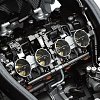I'm often amazed at how many motorcycle people know The Way Things Are, but have little interest in understanding why things are the way they are. This article will be the first in a series of little missives in which we take a look into that issue. Today, we glimpse into the world of fuel delivery. Why do more and more motorcycles have fuel-injection systems?
Every bike in my garage (that’s a total of eight) has a carburetor. The first fuel-injection system on a streetbike debuted in 1980, but for the most part, carbs were how motorcycles mixed air and fuel right up to the turn of the century. (It got hard to ignore fuel injection around that time, anywho.)
Now, I work with folks who, by and large, ride fuel-injected motorcycles. They give me furtive sideways glances, shake their heads, make pitying expressions, and act like I’m a general Luddite about things. (I am.) Fuel injection is now The Way Things Are. I’ve asked many of these folks why fuel injection is better than my clunky old carburetors.
"It’s just better. There’s no choke," is one answer I get.
Now, as a man who has many times fiddled with an old bike to get it to tick again, I can sort of understand the appeal to that. But really: pull the knob, kick it to life, put your gloves on, ride off, and gradually disengage the choke/enrichener/fast idle device as you ride your first few miles. Easy-peasy. It took me longer to think about it and type it out than it does to do it.
So I press on. Come on, what are you really getting with fuel injection?
"Better fuel economy," they tell me. Nope.
"Well, then it makes more horsepower. My bike has way more oomph than the older bikes."
Sorry, that’s not it either. I mean, the bikes now are faster, but only the tiniest smidgen of that added power can be attributed to fuel injection.
There’s an amalgam of reasons carburetors are becoming a quaint novelty, but before we get into that, we need a brief history lesson on why carbs were king until fairly recently in moto history.
Why carbs ruled the moto-landscape
First and foremost, carbs ruled because that's what we had. When motorcycles debuted, carburetors were the only way to mix fuel and air in the right proportions for an engine to digest them. For eight decades, they didn’t seem to be broken, so nobody put much effort into fixing them! Early iterations of fuel injection were large and hard to tune, and many produced some terribly "snatchy" throttles. (Some, though not many, are still guilty of that.) Up until the early years of this century, carbs just worked better.
Carbs also worked well with the crappy electrical systems most motorcycles had. Manufacturers didn't have to work very hard to power a few lights and the ignition, but fuel injection requires pressurized fuel. The easiest way to do that is with a fuel pump, which is typically electrically operated. That pump sucks down quite a bit of juice and requires a better, more expensive electrical system.
Carburetors seemed to be fine and good, until someone realized trees are people, too. Or something like that. It turns out that running internal combustion engines is pretty hard on the planet.
Why carburetors began to fade away
To start with, carbs pollute. Not the way most people think, though. Carburetors may put out a little more pollution through the tailpipe than fuel injection, but the bigger difference is when the bike isn't running. Carburetors have a bowl in which fuel sits, and that fuel evaporates. Mama Nature, it turns out, does not have the same penchant for those pesky unburned hydrocarbons that I do. Fuel-injection systems are essentially sealed, so they're not allowing unburned fuel to escape when the motorcycle is parked.
The other issue is that carbs are imprecise. Not imprecise in a bad way. They just cannot be adjusted as quickly as a fuel-injection system, because they are mechanical. Without getting too overly techy, air and fuel need to be mixed in a precise ratio, somewhere between, say, about 12 to 14.7 parts air for every one part of fuel. Most mechanics who put together a bike in the back yard are shooting for that 12 number. That end of the spectrum is where horsepower is found. A nice, rich mix gets maximum fuel charge into the cylinders, and has the added benefit of helping to cool the engine.

At the other end is the 14.7 number. Modern fuel injection systems try to hover around that number by constantly adjusting the air/fuel mix, sometimes dozens of times each second. Modern fuel-injection systems try to keep the mix lean when you’re cruising, such as when your throttle is a quarter of the way open, and then richen it up very fast when you need to go fast, such as when your throttle is pinned.
For many years, motorcycles sort of flew under their radar, when it came to Environmental Protection Agency regulations. But, with pollution laws really starting to have teeth for motorcycles, the manufacturers used the finer control of the air/fuel mixture that's made possible by fuel injection to meet the letter of the law. Manufacturers also started using catalytic converters. Many bikes now are equipped with them. And the catalysts inside them are kind of picky. They can be easily rendered useless by chemicals that coat their surfaces. One of the items that can coat them is soot from unburned fuel particles, which often occur inside an engine running "fat" — towards the 12:1 end of the air/fuel spectrum.

That’s the long and short of things. Fuel injection doesn’t give appreciably more power, and it doesn’t provide much better gas mileage. Fuel injection does allow for more accurate control of the air/fuel ratio, and in doing so, allows a bike to run cleaner and keep a catalytic converter on board. With aftermarket tuning software, it also allows much finer adjustments of the fuel map.
Carburetors also have advantages. They are more affordable to tinker with. Tuning with a handful of jets can usually be done for only a few dollars, whereas fuel-mapping software on an injected bike begins at a few hundred bills, in most cases. Carburetors are infinitely more rebuildable and user-serviceable than fuel injection, so for those traveling to remote places, carbs can have a slight edge. And carbs did not hold back motorcycle performance. Remember the Honda CBR1100XX Blackbird? That old carbureted dinosaur made 133 horsepower in 1998. That's still a very respectable number, even 15 years later.
Ultimately, both methods of fuel delivery have their applications, fans, and detractors. It’s unlikely we’ll see a resurgence of carburetors in the future, due to environmental concerns. Fuel injection is, at this point, smooth and capable of more accurate, affordable fueling than any other method of atomizing the fuel and air mixture that humans have developed to date. We’re able to make our bikes run cleaner without sacrificing much at all. Fuel injection is reliable, and hey — you don’t have to figure out how to use an enrichener!































 Riders Preferred Membership
Riders Preferred Membership


